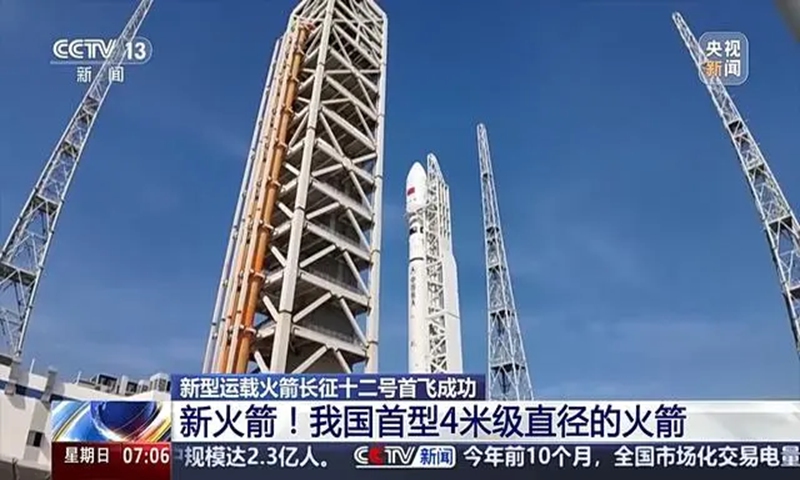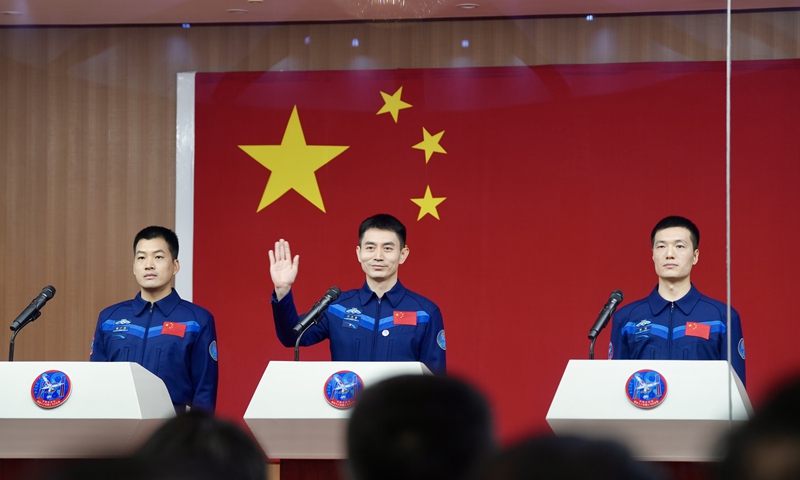
The Long March-12 carrier rocket sends two experimental satellites into their planned orbits on November 30, 2024. Photo: CCTV
China's first commercial space launch site, the Hainan Commercial Space Launch Site, carried out its maiden mission on Saturday, with the Long March-12, a newly developed carrier rocket in the series, successfully delivering two satellites into designated orbits.
The rocket soared into the sky as the erector was moved aside. The debut of the Long March-12 is packed with a sense of cutting-edge innovations thanks to the application of a "zero-second detachment" technique.
This launch demonstrates China's dedication to advancing its space transportation infrastructure. With the new model rocket ready for high-frequency launches, China is poised to accelerate satellite constellation deployment.
The new rocket model, developed by Shanghai Academy of Spaceflight Technology (SAST), incorporates state-of-the-art design features. Measuring approximately 62 meters in length, the two-stage rocket is China's first 4-meter-class carrier rocket, and making it China's most powerful single-core rocket to date, the Global Times learned at the launch site.
Enhanced capability allows for farther journeys and heavier payloads. The Long March-12 boasts a payload capacity of no less than 12 tons to low Earth orbit (LEO) and 6 tons to a 700-kilometer sun-synchronous orbit. From the bottom, its 3.8-meter-diameter rocket body accommodates four engines, each with a thrust of 1,250 kilonewtons. These engines are innovative liquid oxygen-kerosene engines with post-pump gimbaling mechanism.
"This design helps make the structure more compact, allowing more engines to be arranged within the same rocket diameter, effectively increasing its payload capacity," noted Zhao Zhijie from the China Aerospace Science and Technology Corporation.
The Long March-12 stands out in the Long March rocket family with its sleek, slender design, featuring neither boosters nor tail fins.
Looking at the "family tree" of the Long March series, rockets vary in their dimensions. Aside from the game-changing 5-meter diameter of the Long March-5, most Long March rockets have a diameter of 3.35 meters. The new model, however, introduces an innovative design as the first to feature a 4-meter diameter. This innovation allows the rocket to maintain compatibility with railway transportation while accommodating more engines to achieve greater payload capacity.
"This slim, tall, and booster-free design of the rocket offers several advantages. Compared to rockets with attached boosters, the single-core design reduces the number of stage separations, providing inherent benefits such as higher reliability and lower costs. However, it also presents a technical challenge - wobbling. Therefore, significant efforts have been made to address this issue," Kang Guohua, a senior member of the Chinese Society of Astronautics and professor of Aerospace Engineering at Nanjing University of Aeronautics and Astronautics, told the Global Times on Sunday.
"Additionally, since the rocket uses liquid oxygen and kerosene as propellants, the costs are further reduced," Kang added. "This type of rocket provides a strong basis for frequent launches - it's fast to produce, inexpensive, and reliable. These features are exactly what is urgently needed for deploying large constellations of satellites into orbit."
Another notable design is that the rocket features customizable payload fairings, available in 4.2-meter or 5.2-meter diameters, providing adaptability to meet diverse mission needs, according to the SAST.
Zeng Wenhua, a research fellow from SAST, told the Global Times that the 5.2-meter fairing is tailored for satellite constellation missions. In the future, it could support satellite stacking configurations for future missions.
"Constellation deployment missions involve placing multiple satellites in a single orbit, which requires enhanced performance from the payload fairing," said Zeng. "The Long March-12 rocket is the first from our academy to feature a 5.2-meter-diameter large payload fairing, making it well-suited for LEO internet constellation missions."
The Long March-12 vehicle is prepared for high-frequency launch operations in the future, bolstering China's capacity for Sun-synchronous orbit insertions and LEO constellation deployments, further advancing the nation's space transportation infrastructure.
The new rocket model has also laid the groundwork for future reusable rockets, experts previously said. "If you compared the parameters of the Long March-12 with SpaceX's currently most reliable Falcon 9 reusable rocket, the specifications of the two are quite similar. SpaceX has already demonstrated the feasibility of this approach," Kang said.
The mission also marked the inauguration of the Hainan Commercial Space Launch Site, China's first dedicated commercial space launch facility. Completed in just 878 days from construction to operation, the Global Times learned.
The successful launch from the spaceport has filled the gap in China's lack of a commercial space launch site. It marks the completion of the full industrial chain of the commercial aerospace sector, which includes satellite and rocket manufacturing, commercial launch site, and satellite data application services.
This achievement bolsters China's capabilities for LEO constellation deployments and other space infrastructure projects.
The satellites launched aboard the Long March-12 were developed by China's private company GalaxySpace. The company's chief technology officer Zhu Zhengxian told the Global Times on Sunday that he believes China's commercial aerospace industry is ushering in new era.
"This mission marks an important step forward. Commercial aerospace will play a key role in strengthening China's position as a leading space power," Zhu said.



